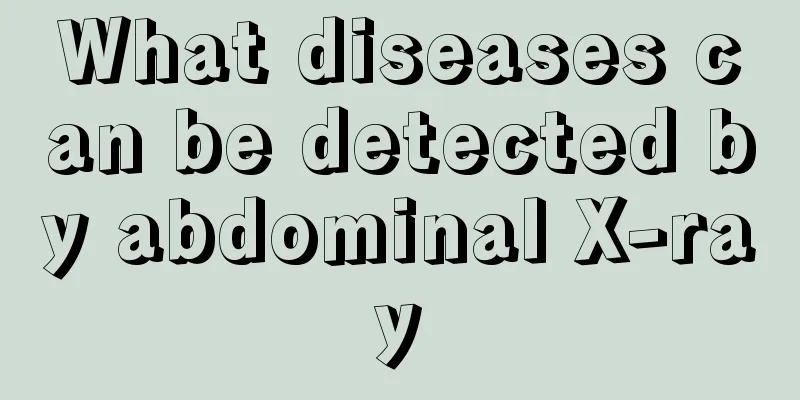What diseases can be detected by abdominal X-ray

|
When people conduct abdominal examinations, there are many examination methods to choose from, and the examination results and diseases corresponding to each examination method are also different. Abdominal fluoroscopy is also a form of examination. It mainly uses the principle of X-ray to perform fluoroscopic examination of people's abdomen, which can effectively detect pathological reactions in the gastrointestinal organs. What are the main diseases that can be detected through abdominal radiography? The role of abdominal fluoroscopy Abnormal results: (1) The most common abnormal gas outside the intestine is free gas under the diaphragm, which is mostly caused by perforation of gastric or duodenal ulcers. Tumors, inflammation, trauma, etc. can also cause gastrointestinal perforation. Most gastrointestinal perforations produce typical pneumoperitoneum X-ray signs due to free gas in the abdominal cavity, but in a few cases there may be no X-ray manifestation of pneumoperitoneum. Some people have proved through experiments that 1 ml of free gas in the abdominal cavity can be shown on X-rays, but this is related to some conditions and cannot be seen on X-rays under all conditions. If necessary, a horizontal abdominal plain film with the right side facing upward can be taken. Be careful not to mistake the interpositioned colon or diaphragm for pneumoperitoneum. In addition, certain abdominal abscesses and larger penetrating ulcers can also cause localized extraintestinal gas shadows. (2) Abnormal gas distribution and fluid accumulation in the intestine. Pay attention to whether there is abnormal intestinal bloating and gas-liquid level, which is of great significance in the diagnosis and differential diagnosis of intestinal obstruction. In mechanical intestinal obstruction, the intestine above the obstruction site is bloated and has a stepped air-liquid level; in paralytic intestinal obstruction, the area from the stomach to the large intestine can be inflated and expanded. Reflex intestinal congestion caused by inflammation of some abdominal organs often involves the intestines near the lesions. When diagnosing intestinal obstruction, attention should also be paid to the presence or absence of signs of strangulation. (3) The outline, size and position of the liver, spleen and kidneys. Obvious enlargement of the liver and spleen can often be seen on abdominal plain films. Hepatomegaly can be seen in malignant tumors, hydatid cysts, cysts and cavernous hemangiomas. Splenomegaly is seen in portal hypertension, malignant lymphoma, reticulum cell sarcoma, etc. In addition to increasing in size (as seen in hydronephrosis, cysts, tumors, etc.), the kidneys can also decrease in size (such as atrophic kidneys). The kidneys of patients with renal ptosis are located low and have a large degree of mobility. Trauma to the liver, spleen, and kidneys can all manifest as blurred outlines, and perirenal inflammation can also have this symptom. (4) Changes in the psoas muscle shadow: In addition to the common lumbar tuberculosis which can cause the psoas muscle shadow to widen, the disappearance of the psoas muscle shadow can be seen in perirenal abscess, renal malignant tumor (some people report that 50% of the psoas muscle shadow disappears), retroperitoneal tumors, etc. (5) Is there a general increase in density or abnormal mass? A large amount of ascites can cause a uniform increase in abdominal density. If there is free gas in the abdominal cavity, a large liquid level can be shown. However, giant ovarian cysts may also have similar manifestations, so care should be taken to differentiate them. The abnormal mass appears as a localized increase in density, sometimes with a visible edge. (6) Whether there is abnormal calcification. The most common abdominal calcifications include urinary stones, abdominal lymph node calcification, gallstones, etc. The calcification shadows of some lesions have certain characteristics. For example, some kidney stones appear as staghorn calcifications in the renal pelvis area, bladder stones may be composed of layered round or oval calcifications, lymph node calcifications may appear as numerous spot-like shadows with uneven density and irregular shapes, and teratomas may show shadows of teeth and bones. : : : : : : : : : : : : : : : (7) Disappearance of the extraperitoneal fat layer on the lateral abdominal wall. This sign can be seen in peritonitis but can only be observed when the quality of the photograph is good. (8) Whether there are any abnormalities in the bones. Certain diseases of the abdominal organs are closely related to the skeletal system. For example, renal tuberculosis may be combined with spinal tuberculosis. Malignant tumors of the internal organs may metastasize to the bones. Some urinary stones are a manifestation of systemic metabolic diseases and may therefore be combined with bone changes (such as hyperparathyroidism). (9) Pay attention to the position, movement and contour of the diaphragm to see if there are any abnormalities. People who need to be examined: People who have abnormal abdominal pain. |
<<: The correct order for abdominal examination is
>>: What foods promote bowel movements
Recommend
How to make fingers thinner when they become thicker
It is said that fingers are a person's second...
How to make hair fluffy when it is close to the scalp
Nowadays girls are more concerned about the probl...
Sleep with your arms raised above your head
People sleep in all kinds of different positions,...
Can high temperature kill Aspergillus flavus?
Aflatoxin is a relatively common fungus. As it is...
What symptoms should we pay attention to for prostate cancer and how to prevent prostate cancer
Patients with prostate cancer must pay attention ...
The effects and methods of TCM in treating colorectal cancer
In traditional Chinese medicine, the treatment of...
There is a patch of skin on my face that feels rough
The skin on the human face is usually very smooth...
What should I do if my anus hurts when I defecate
When anal pain occurs during bowel movements, pat...
Adhesions are more likely to occur after micro-acupuncture surgery
Acupuncture is a very common treatment technology...
What to do if breast cancer patients have joint pain after taking trometazoline tablets?
What should I do if I suffer from joint pain afte...
Anxiety disorder physical pain
As people's work pressure increases, more and...
How to treat ascites in advanced liver cancer? Generally, interventional or minimally invasive methods are used for treatment
Ascites in the late stage of liver cancer is very...
What are the early symptoms of mumps?
The occurrence of mumps can be said to be a relat...
What does rectal cancer ultrasound examination mean
With the continuous development of life, people&#...
The efficacy and function of oyster shell
After eating oysters, a very hard shell will be l...









